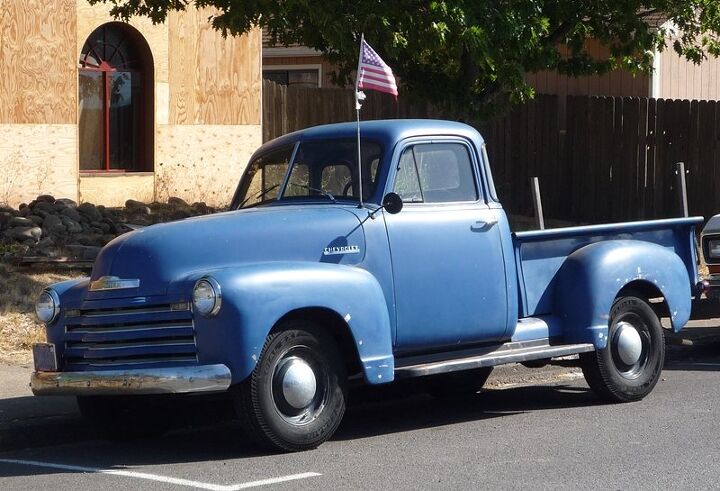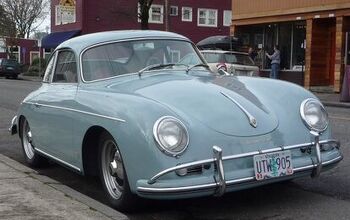Curbside Classic: My All-Time Favorite Truck – 1951 Chevrolet

Wow! History in the making here: my all-time favorite car and truck in the same week on Curbside Classics. I wouldn’t have guessed Edward would chose to do a Truck Thursday, but he’s the boss, so I’m pulling out all my stops. I’ve been collecting “Advanced Design” Chevys all year, but this is my favorite. And this truck is the archetype of all pickups, in all its simple but beautiful essence. So given the fact that full-size pickups are the best selling vehicle, and this is the mother of all post-war trucks, perhaps the title should read: The Most American Vehicle Ever.
If you grew up in the fifties or sixties, this truck is probably deeply ingrained into your memory banks. We moved to Iowa in 1960, and these were everywhere, still hard at work on the small family farms of the time. The facts are that Chevy was the number one seller back than, but I suspect it was by a large margin, because Fords, Dodges and Internationals just weren’t anywhere near as ubiquitous as these. And that’s carried forward through the decades to today.
When I moved back to Iowa in the early seventies, the kids were all buying them for peanuts from the retiring farmers. At the time when Dylan and Rock was all going country, this was the cool ride to just be seen in or for hauling a load of manure to the organic garden. The placid hum of their 216 cubic inch “stovebolt” sixes was as much a part of the aural background then as Working Man’s Dead. Only once did I hear that venerable motor being abused beyond belief, and I won’t soon forget that:
When we lived a few blocks from the Pacific in Santa Monica in the late seventies, there was a rather volatile young couple who had two of these as well as a small Chevy school bus of the same vintage that they lived in part of the year. They rented a garage facing the alley behind our apartment building where they spent the winters, in the garage that is (they were ahead of their times that way). One night I heard the distinctive sound of a stovebolt six running wide open in first gear, its rpm only limited by valve float. The young woman was repeatedly driving the tortured Chevy up and down the alley, and every time she passed the garage, the guy would throw a piece of their furniture out in front of the truck, in a vain attempt to stop it. The combination of cracking wood and the wailing Chevy bumping over mattresses, dressers and chairs are seared into my memory. Eventually, she tired of pounding her furniture into a pulp and drove off, the screaming Chevy slowly melding into the background noise. There was quite a mess in the alley the next morning.
The point I was trying to make was that these old trucks are hard to stop or kill, even in the most trying of domestic circumstances. And rust-free Chevys of this vintage were easy and cheap picking in the agricultural valleys of California until well into the eighties. And now: well, I’ve got about a half a dozen of them in my files, but have yet to find one Ford or Dodge of this vintage on the streets. So what made these trucks so wonderful, venerable and indestructible, even in the face of a determined hurler of furniture?
In an interesting preview of GM’s future priorities, the Chevy (and GMC) “Advanced Design” trucks were GM’s first all-new post-was vehicles. They arrived in June 1947, over a year before the new ’49 Chevy cars. It was a dramatic improvement over its predecessor; cute as the thirties pickups were, their cabs were claustrophobic and lacked visibility. Not so with our featured truck, which has the optional rear-quarter windows. And the cabs were wide enough for three guys whose bodies still reflected a pre-Big-Gulp diet and physical work.
They were built right through into 1955, with just minimal changes. If my source is correct, this is a ’51 by virtue of having the vent windows (new for that year), but not having the push-button door handles that came in ’52. For that matter, this is a late ’51, because it has eight boards in the bed instead of nine. Not that it matters that much to me, but I don’t want to let the historians down.
Chevy’s engine didn’t need to be redone though; the venerable 92 hp 216 cubic inch OHV six had been around since 1937, and was a well-proven lump, despite its primitive non-fully pressurized lubrication system. It churned out a steady flow of torque right from idle speed, as I well remember as a ten year-old driving one on the Mennonite farm where I spent my youthful summers. I was used to dumping the clutch on the Farmalls, and the Chevy took it just as well. It was hard to give it gas and let out the clutch simultaneously while practically standing up to see over the dash and hood.
I could go on all day waxing and reminiscing about these old Chevys, but the blogosphere isn’t conducive to that. This won’t be the last old Chevy truck I post, so we’ll save some of it for then. And you probably have plenty of good stuff to add. In case you’re wondering why I drive a ’66 Ford F-100 instead of one of these, just look in the bed: I don’t feel like replacing rotted wood boards, or raising splinters with my shovel on them. But in the Niedermeyer Fantasy Garage, there’s a space for this truck waiting, and in exactly this condition: enough patina to show that it hasn’t forgotten what it was made to do: work.

More by Paul Niedermeyer
Latest Car Reviews
Read moreLatest Product Reviews
Read moreRecent Comments
- Analoggrotto The ORDER BOOKS in Australia have netted 300% above projection. Australia is so awesome and they are embracing the Telluride DIesel to overtake the Prado. Pentagon data, and eATPs rule the discussion, bar none. Toyota fans can go home with their sorry little turbo 4 cylinder.
- Analoggrotto Such a loving artful tribute to TTAC's greatest godfather is much welcomed. There's a new and better PORSCHE and they are from SOUTH KOREA baby! After years of Japanese oppression, SOUTH KOREA is the TIGER of the Far EAST. We just need a modern day James Dean and that would be Rhys Millen!
- Groza George Our roads and bridges are crumbling and increasing vehicle weight will only make bridges crumble faster. We need more infrastructure work.
- Wolfwagen Pennsylvania - Two long straights, 1 medium straight, 1 super short straight and a bunch of curves all on one end
- Haze3 EV median weight is in the range of 4500-5500lbs, similar to the low end of full size pickup trucks and SUV's or typical mid-size PU's and SUV's. Obviously, EV Hummers and PU's are heavier but, on average, EV=PU or mid/full SUV is about right. EV's currently account for ~1% of the cars on the road. PU's account for 17% and SUV's count for over 40%. If we take out light SUV's, then call it 30% SUV or so. So, large-ish PU's and SUV's, together, account for ~50% of the US fleet vs 1% for EV's. As such, the fleet is ALREADY heavy. The problem is that EV's will be making the currently lighter 50% heavier, not that PU/SUV haven't already done most of the damage on avg mass.Sure, the issue is real but EV responsibility is not. If you want to get after heavies, that means getting after PU/SUV's (the current problem by 40-50x) first and foremost.








































Comments
Join the conversation
I had one of these as a daily driver as recently as ~2000. Neat old truck. 100% stock except the white spoke 4WD wheels. Not raised. Needed kingpins badly. Drove it 6-7 miles each way to work and all over town. Drove it ~100 over the TN mtns to Chattanooga and back. It really wasn't well suited to highway work. No seatbelts, no brakes (got hot easily), kingpins worn, low gears, only three gears too. Still the 50 year old engine did very well. Drove it to town several times with our first born child in his childseat lashed to the seat frame in the center with myself crammed into the driver's side and my bride in the passenger side. Yep, they didn't use child restraints in those days... He was as safely lashed and we were going slow. I wanted to keep it but we wanted a nicer house so away it went to NY State. My motorcycle to someone else. If I kept it the truck needed the gas tank relocated outside of the cab under the bed for safety's sake and the kingpin job. I would have considered a four speed tranny, a higher rear end gear and better -maybe still drums- brakes. Nothing wrong with these old trucks though. Perfectly good tools. Makes me wonder why we need such large powerful trucks today though. My father has a streerodded example in his garage and we have another project '50/235 c.i. in a barn. I hope I get to it before he does. I'd like another antique truck with some of the hidden upgrades listed above.
wow this isn't visited much glad I found it. Back in High School I bought a 1952 panel 3800 nice old truck. The directionals were on top of the fenders.